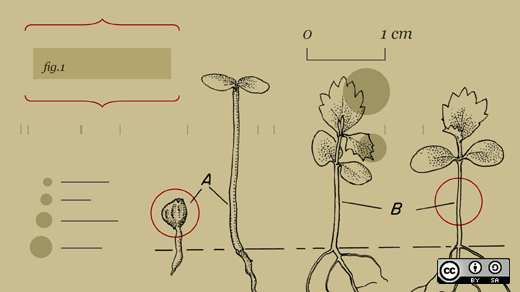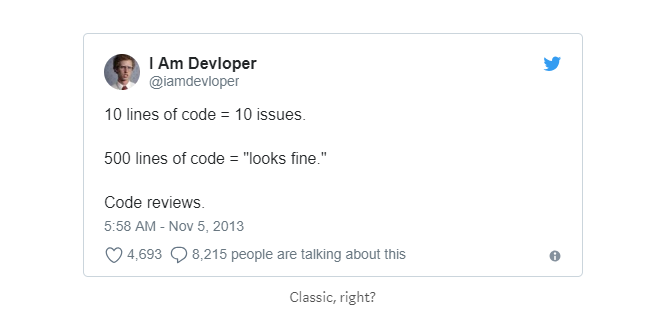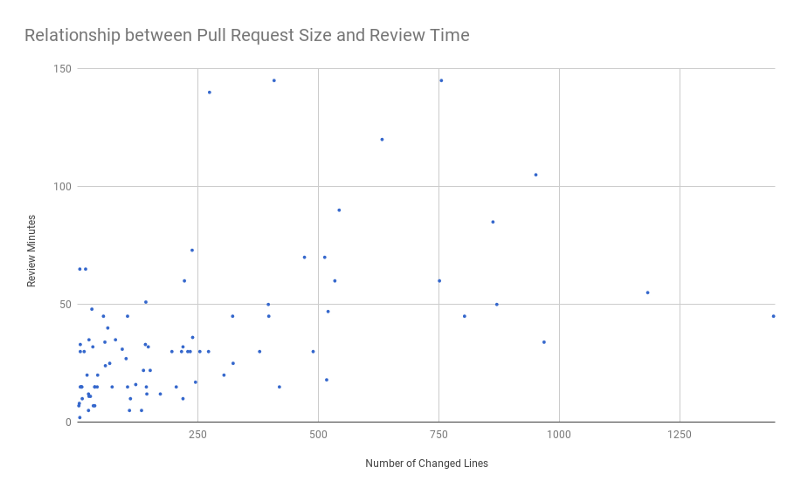mirror of
https://github.com/LCTT/TranslateProject.git
synced 2024-12-26 21:30:55 +08:00
154 lines
5.9 KiB
Markdown
154 lines
5.9 KiB
Markdown
|
|
Anatomy of a perfect pull request
|
|||
|
|
======
|
|||
|
|

|
|||
|
|
|
|||
|
|
Writing clean code is just one of many factors you should care about when creating a pull request.
|
|||
|
|
|
|||
|
|
Large pull requests cause a big overhead during the code review and can facilitate bugs in the codebase.
|
|||
|
|
|
|||
|
|
That's why you need to care about the pull request itself. It should be short, have a clear title and description, and do only one thing.
|
|||
|
|
|
|||
|
|
### Why should you care?
|
|||
|
|
|
|||
|
|
* A good pull request will be reviewed quickly
|
|||
|
|
* It reduces bug introduction into codebase
|
|||
|
|
* It facilitates new developers onboarding
|
|||
|
|
* It does not block other developers
|
|||
|
|
* It speeds up the code review process and consequently, product development
|
|||
|
|
|
|||
|
|
|
|||
|
|
|
|||
|
|
### The size of the pull request
|
|||
|
|
|
|||
|
|

|
|||
|
|
|
|||
|
|
The first step to identifying problematic pull requests is to look for big diffs.
|
|||
|
|
|
|||
|
|
Several studies show that it is harder to find bugs when reviewing a lot of code.
|
|||
|
|
|
|||
|
|
In addition, large pull requests will block other developers who may be depending on the code.
|
|||
|
|
|
|||
|
|
#### How can we determine the perfect pull request size?
|
|||
|
|
|
|||
|
|
A [study of a Cisco Systems programming team][1] revealed that a review of 200-400 LOC over 60 to 90 minutes should yield 70-90% defect discovery.
|
|||
|
|
|
|||
|
|
With this number in mind, a good pull request should not have more than 250 lines of code changed.
|
|||
|
|
|
|||
|
|

|
|||
|
|
|
|||
|
|
Image from [small business programming][2].
|
|||
|
|
|
|||
|
|
As shown in the chart above, pull requests with more than 250 lines of changes usually take more than one hour to review.
|
|||
|
|
|
|||
|
|
### Break down large pull requests into smaller ones
|
|||
|
|
|
|||
|
|
Feature breakdown is an art. The more you do it, the easier it gets.
|
|||
|
|
|
|||
|
|
What do I mean by feature breakdown?
|
|||
|
|
|
|||
|
|
Feature breakdown is understanding a big feature and breaking it into small pieces that make sense and that can be merged into the codebase piece by piece without breaking anything.
|
|||
|
|
|
|||
|
|
#### Learning by doing
|
|||
|
|
|
|||
|
|
Let’s say that you need to create a subscribe feature on your app. It's just a form that accepts an email address and saves it.
|
|||
|
|
|
|||
|
|
Without knowing how your app works, I can already break it into eight pull requests:
|
|||
|
|
|
|||
|
|
* Create a model to save emails
|
|||
|
|
* Create a route to receive requests
|
|||
|
|
* Create a controller
|
|||
|
|
* Create a service to save it in the database (business logic)
|
|||
|
|
* Create a policy to handle access control
|
|||
|
|
* Create a subscribe component (frontend)
|
|||
|
|
* Create a button to call the subscribe component
|
|||
|
|
* Add the subscribe button in the interface
|
|||
|
|
|
|||
|
|
|
|||
|
|
|
|||
|
|
As you can see, I broke this feature into many parts, most of which can be done simultaneously by different developers.
|
|||
|
|
|
|||
|
|
### Single responsibility principle
|
|||
|
|
|
|||
|
|
The single responsibility principle (SRP) is a computer programming principle that states that every [module][3] or [class][4] should have responsibility for a single part of the [functionality][5] provided by the [software][6], and that responsibility should be entirely [encapsulated][7] by the class.
|
|||
|
|
|
|||
|
|
Just like classes and modules, pull requests should do only one thing.
|
|||
|
|
|
|||
|
|
Following the SRP reduces the overhead caused by revising a code that attempts to solve several problems.
|
|||
|
|
|
|||
|
|
Before submitting a PR for review, try applying the single responsibility principle. If the code does more than one thing, break it into other pull requests.
|
|||
|
|
|
|||
|
|
### Title and description matter
|
|||
|
|
|
|||
|
|
When creating a pull request, you should care about the title and the description.
|
|||
|
|
|
|||
|
|
Imagine that the code reviewer is joining your team today without knowing what is going on. He should be able to understand the changes.
|
|||
|
|
|
|||
|
|
![good_title_and_description.png][9]
|
|||
|
|
|
|||
|
|
What a good title and description look like
|
|||
|
|
|
|||
|
|
The image above shows [what a good title and description look like][10].
|
|||
|
|
|
|||
|
|
### The title of the pull request should be self-explanatory
|
|||
|
|
|
|||
|
|
The title should make clear what is being changed.
|
|||
|
|
|
|||
|
|
Here are some examples:
|
|||
|
|
|
|||
|
|
#### Make a useful description
|
|||
|
|
|
|||
|
|
* Describe what was changed in the pull request
|
|||
|
|
* Explain why this PR exists
|
|||
|
|
* Make it clear how it does what it sets out to do— for example, does it change a column in the database? How is this done? What happens to the old data?
|
|||
|
|
* Use screenshots to demonstrate what has changed.
|
|||
|
|
|
|||
|
|
|
|||
|
|
|
|||
|
|
### Recap
|
|||
|
|
|
|||
|
|
#### Pull request size
|
|||
|
|
|
|||
|
|
The pull request must have a maximum of 250 lines of change.
|
|||
|
|
|
|||
|
|
#### Feature breakdown
|
|||
|
|
|
|||
|
|
Whenever possible, break pull requests into smaller ones.
|
|||
|
|
|
|||
|
|
#### Single Responsibility Principle
|
|||
|
|
|
|||
|
|
The pull request should do only one thing.
|
|||
|
|
|
|||
|
|
#### Title
|
|||
|
|
|
|||
|
|
Create a self-explanatory title that describes what the pull request does.
|
|||
|
|
|
|||
|
|
#### Description
|
|||
|
|
|
|||
|
|
Detail what was changed, why it was changed, and how it was changed.
|
|||
|
|
|
|||
|
|
_This article was originally posted at[Medium][11]. Reposted with permission._
|
|||
|
|
|
|||
|
|
--------------------------------------------------------------------------------
|
|||
|
|
|
|||
|
|
via: https://opensource.com/article/18/6/anatomy-perfect-pull-request
|
|||
|
|
|
|||
|
|
作者:[Hugo Dias][a]
|
|||
|
|
选题:[lujun9972](https://github.com/lujun9972)
|
|||
|
|
译者:[译者ID](https://github.com/译者ID)
|
|||
|
|
校对:[校对者ID](https://github.com/校对者ID)
|
|||
|
|
|
|||
|
|
本文由 [LCTT](https://github.com/LCTT/TranslateProject) 原创编译,[Linux中国](https://linux.cn/) 荣誉推出
|
|||
|
|
|
|||
|
|
[a]:https://opensource.com/users/hugodias
|
|||
|
|
[1]:https://smartbear.com/learn/code-review/best-practices-for-peer-code-review/
|
|||
|
|
[2]:https://smallbusinessprogramming.com/optimal-pull-request-size/
|
|||
|
|
[3]:https://en.wikipedia.org/wiki/Modular_programming
|
|||
|
|
[4]:https://en.wikipedia.org/wiki/Class_%28computer_programming%29
|
|||
|
|
[5]:https://en.wikipedia.org/wiki/Software_feature
|
|||
|
|
[6]:https://en.wikipedia.org/wiki/Software
|
|||
|
|
[7]:https://en.wikipedia.org/wiki/Encapsulation_(computer_programming)
|
|||
|
|
[8]:/file/400671
|
|||
|
|
[9]:https://opensource.com/sites/default/files/uploads/good_title_and_description.png (good_title_and_description.png)
|
|||
|
|
[10]:https://github.com/rails/rails/pull/32865
|
|||
|
|
[11]:https://medium.com/@hugooodias/the-anatomy-of-a-perfect-pull-request-567382bb6067
|